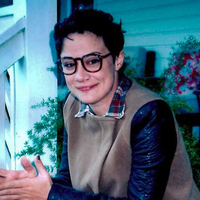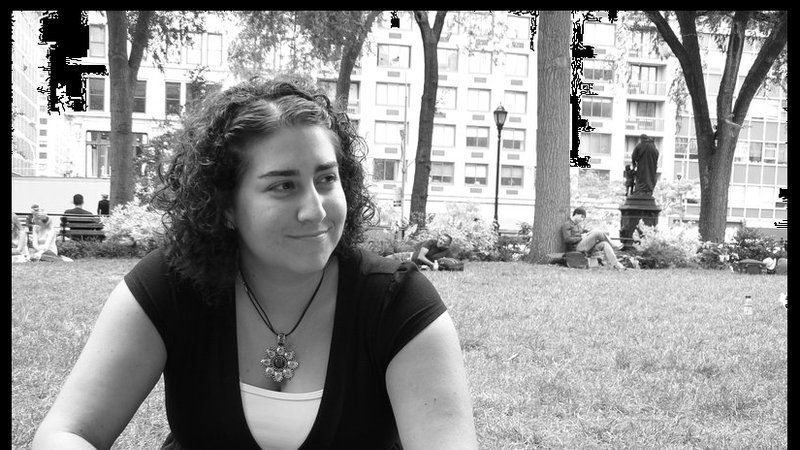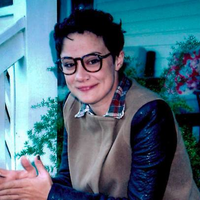Battling My Body: Being Queer with an Eating Disorder
Treating an eating disorder is complicated, especially if you're queer.

“The last thing I'd want is for someone to think that being queer—and not knowing how to situate my body in relation to my queerness—somehow caused my eating disorder,” explains Emily*, a 32-year-old novelist and poet from Chicago, Illinois. Emily struggled with anorexia during her teen years, spent more than four years in treatment, including time at an eating disorder treatment center, and has battled with related dysmorphia for most of her adult life. "If anything, I think of eating disorders as a speech act no one really knows how to interpret."
Being queer may not have caused Emily’s eating disorder, but it did put her at higher risk of suffering from one. The earliest research on the prevalence of eating disorders in the LGBTQ+ community focused on cisgendered lesbians and bisexual women. At the time, the medical community largely considered eating disorders to be an mental illness confined to straight, white, young women, and studies tended to conclude that the rates of eating disorders in queer populations were lower than those of their heterosexual peers. But these studies were eventually widely criticized, partly because they relied on small, relatively homogenous population samples.
Recently, experts have begun to suggest that the LGBTQ+ community as a whole is actually a high-risk population. According to the National Eating Disorders Association (NEDA), “as early as 12, gay, lesbian and bisexual teens may be at higher risk of binge-eating and purging than heterosexual peers.” Turning their lenses (finally) toward the lived experiences of the trans and nonbinary population, researchers have found that body dissatisfaction plays a major role in gender dysphoria and that this dissatisfaction can manifest in patterns of disordered eating. While not all trans folks experience dysphoria, both trans men and trans women (and individuals who fall under the genderqueer umbrella) tend to be at higher risk for disordered eating patterns than cisgendered individuals.
If there is one clear thread that has emerged from the scholarship of the last decade, it is this: When it comes to gender identity and sexuality, eating disorders do not discriminate. Eating disorders are intersectional. Andrea, a contributor to the now defunct blog, Science of Eating Disorders, explains that eating disorders affect people of all “genders, ethnicities, ages, abilities, shapes, sizes, sexualities, socioeconomic statuses, cultures, religions, levels of education, family situations, marital statuses, political affiliations, and housing statuses.” While none of these identities or situations cause the eating disorders, they do shape individuals’ experiences with (and recovery from) them.
In order to properly, thoughtfully, and compassionately grapple with the impact of eating disorders in the queer community, we must first consider queer bodies—sexuality, gender identity, gender presentation, traumas, the ways we see ourselves, the ways we see each other, the ways we eat, the ways we don’t—and the visceral, bodied manner in which we move about the world. We know that eating disorders tend to show up during adolescence, a time when a lot of queer and trans individuals are just beginning to grapple with what it means to inhabit a queer body, which, for many (particularly those living in bigoted or un-affirming environments), means grappling with what it means to inhabit a body that feels wrong, foreign, unacceptable, or unlovable.
We must first consider queer bodies and the visceral, bodied manner in which we move about the world.
Adam is a 26-year-old queer trans man from Texas now living in California. At the apex of his battle with anorexia, he weighed 67 pounds. He was 5'2" and in the eighth grade. “I was so disgusted with my form and the gender dissonance it inspired,” says Adam. “I felt simply grotesque. I was pudgy, oily, and growing breasts that I loathed. Between that and the awareness of my sexual orientation, I felt beastly.” And so, Adam took matters into his own hands: He subsisted on Sugar Free Red Bull and calorically measured rations of frozen peaches, rode a stationary bike daily (while wearing a baggy Nightmare Before Christmas sweatshirt and reading horror stories), and slowly started to die. By the time he was involuntarily hospitalized, he had stopped menstruating, was developing signs of osteoporosis, and had lost the ability to regulate his body temperature.
Myra Hendley, the primary therapist at Eating Recovery Center, a national health-care system dedicated to the treatment of serious eating and related disorders, believes there are three things in particular that put the LGBTQ+ community at higher risk for eating disorders: trauma history, weight stigma, and family-of-origin influence.
Get exclusive access to fashion and beauty trends, hot-off-the-press celebrity news, and more.
“The tea is oversteeped,” says Adam of the various traumas LGBTQ+ populations face. The queer community, particularly queers of color, sit at dangerous intersections of multiple marginalizations. Queer and trans people are regularly murdered (a particularly egregious example: 49 people were killed and 53 were injured during the massacre at the queer nightclub Pulse in 2016) and many live under the threat of violence every day. Trans people are at a much higher risk of unemployment and poverty. Sixty percent of survivors of anti-LGBTQ+ hate crimes are people of color.
According to a 2015 study published by the CDC (which did not include trans individuals), 10 percent of LGB students were threatened or injured with a weapon on school property (compared to 5 percent of heterosexual students) and 34 percent were bullied (compared to 19 percent of heterosexual students). LGB students are also more likely to experience sexual dating violence, physical dating violence, and rape than their heterosexual peers.
Transgender students face even higher levels of harassment and violence. Eighty-seven percent reported being verbally harassed at school because of their gender expression. Three-quarters of transgender students reported being sexually harassed.
That harassment often continues beyond adolescence. Corinne, a 27-year-old trans woman living in North Carolina, has spent the last two years recovering from bulimia after she developed signs of organ failure from malnutrition. “Early in my transition, I was ostracized for being visibly transgender, which heightened the dysphoria surrounding my body. On one occasion, a man stood up on a city bus, demanding it stop so he could be ‘rid of my presence,’” she says, “I've been referred to as ugly more times than I can count.”
Unsurprisingly, LGBTQ+ individuals are 3 times more likely to suffer from a mental health condition like depression or anxiety (which are often co-morbid with eating disorders). The CDC reported nearly one-third of gay and bisexual students have recently attempted suicide; 43 percent have seriously considered it. According to the National Transgender Discrimination Survey (NTDS), the prevalence of suicide attempts among trans and gender non-conforming respondents is 40 percent, which vastly exceeds the 4.6 percent of the overall U.S. population.
Cultural pressures that glorify "thinness" or muscularity and place value on obtaining the "perfect body" may contribute to eating disorders. The queer community is not immune to these pressures. In fact, there are specific, distinct reasons those who identify as LGBTQ+ may see their body as wrong. Particularly in the trans and nonbinary communities, dysphoria can precipitate disordered eating patterns. Corinne’s eating disorder manifested when she started to “starve” herself in “an attempt to drop muscle mass and appear more feminine.” For Adam, starving himself was initially an attempt to “embody” femininity. Then, “when I made my body very thin, I looked androgynous. I saw this guilty beauty in myself. I started ‘passing’ as a little boy.”
Gay men disproportionately exhibit image disturbances and eating disorder behavior. According to NEDA, gay men are thought to only make up 5 percent of the total male population, but among men who have eating disorders, 42 percent identify as gay. Says Hendley, “This shocking statistic supports the assumption that body dissatisfaction is highly prevalent and socially noticed in the gay male community.”
“Your error is not in thinking that there’s something wrong where there isn’t, but that you could find a way to circumvent that wrongness by losing weight.”
In territory that is, as yet, largely unplumbed by modern scholarship. Davey Davis, a writer who focuses on culture, sexuality, and genderqueer embodiment, suggests there are other insidious social factors at play. In their piece, 'Inhuman Hunger: How Gendering Diseases Dehumanizes Women, and Hurts All People with Eating Disorders,' Davis explains, “How can doctors, family members, and friends say, in good conscience, Your belief that there is something wrong with your body is evidence of your mental illness, when we know that the bodies of even the most privileged women—straight, white, able-bodied, cisgender, middle-class American citizens—are surveilled, policed, punished, derided, dehumanized, and legislated against.” In the patriarchy, to have a queer body (or a woman’s body, or both) is to have a wrong body and it makes sense to internalize this violence.
“As a person with an eating disorder, your error is not in thinking that there’s something wrong where there isn’t, but that you could find a way to circumvent that wrongness by losing weight,” writes Davis.

Eating disorders, like substance abuse disorders, tend to run in families. Scholarship suggests that there may be a genetic component. Adam, who comes from a long line of Southerners “who were taught to suppress their emotions, a lot of whom never had access to much mental health literacy,” often wonders if his own mother has disordered components to her relationship with food. Mental illness does not occur in a vacuum.
Sarah*, 26, an Arkansan who came out as a lesbian in late 2016, suffered from disordered eating patterns for the bulk of her early 20s. She was putting herself through school on part-time wages and initially used her financial situation to justify her food restriction. “I was saving money by not spending much on food. It was one area of my life that I actually had control over,” she explains. “Once I started losing weight and people began complimenting me on it, I got addicted to feeling attractive.”
Throughout her childhood and adolescence, Sarah watched her mother try different fad diets and weight loss programs; she’d always considered herself fat. “As I got older and ended up bigger than my mother, I was self-conscious about the fact that she must have thought I was fat too,” says Sarah. “She would make off-handed comments about how I needed to watch what I was eating, to watch my figure, that I shouldn't wear certain items of clothing.” Societal pressures (including familial pressures) that demonize fatness are nearly impossible not to internalize.
Fat stigma is more than just a possible cause of disordered eating, it may actually prevent sufferers from getting the help they need. Suma identifies as a queer, fat, femme. Although she has struggled with bulimia since childhood, she had to fight to have her eating disorder taken seriously enough to even seek out options for treatment. “As a fat person, my eating disorder was encouraged, as it caused me to lose weight,” she explains, adding that her mother struggled with anorexia. “The first time that I reached out for help, I was 16 and discussing my fear of eating with my doctor. He told me to ‘keep up the good work.’” Suma credits “discovering the size-positive world on Tumblr and Instagram” with playing a large role in her recovery.
Her eating disorder therapy was inextricably linked to her parents' attempt to exert control over her sexuality.
According to Hendley, there need not be a genetic predisposition for a family to contribute to an individual’s likeliness to develop an eating disorder. She explains, “If a person is part of a non-supportive system, they are likely to develop maladaptive coping skills to deal with anxiety and depression, which can manifest as an eating disorder.”
Emily feels that her eating disorder therapy (which occurred when she was a minor) was inextricably linked to her parents' attempt to exert control over her sexuality. “I can't even fleetingly imagine my parents learning about my sexual identity without immediately picturing my room at the ED treatment center,” she says, “which is to say, picturing myself locked in, back in the position where I'd say or do whatever I need to just to get out."

Emily's parents and therapist deemed her recovery successful when her life (and body) began to look heteronormative and feminine. “By emphasizing heteronormative markers of development, my ED treatment effected a kind of sexual erasure,” she explains. For her, even the term “eating disorder” is problematic because, for so many, it is such a direct result of a dysfunctional family unit. “The diagnosis of a ‘disorder’ effectively ‘others’ the individual in question and alleviates parents or authority figures from the responsibility of acknowledging their own ‘disorders.’”
Some researchers do use the “restoration of sexual function” as a diagnostic benchmark, for better or for worse (mostly because sexual “dysfunction” is common among cisgendered women with eating disorders, which is not to say this phenomenon is limited to cisgendered women, but, of course, the studies are). They link the restoration of sexual function to “body uneasiness reduction.” If this is even occasionally the case, it is crucial for treatment professionals to provide what Hendley calls “Safe Zones” for LGBTQ+ individuals, both out and closeted.
And so what should queered recovery look like? First, we need to collectively decide to value and honor bodies. All of them—fat, thin, queer, straight, trans, nonbinary, cis, disabled, non-disabled, and on and on. We must eliminate fat stigma and move towards fat acceptance. We must dismantle “the greater narrative that insists there can be ‘good’ bodies and ‘bad’ bodies,” says Davis. There are no bad bodies.
Next, we need good resources. Queered recovery requires safe, affirming, curious, financially accessible, and culturally competent therapists and treatment professionals. It requires healthy, compassionate support networks to “provide safe and reliable feedback” to individuals who are struggling, says Hendley.
Queered recovery requires an unambiguous embracing of suffering individuals of all identities, sizes, races, ethnicities, and socioeconomic backgrounds. Queered recovery demands intersectionality.
*Names have been changed
Laura is a queer, Lumbee writer and editor based in Durham, NC, whose work focuses on the interplay between identity and power structures with a focus on gender, sexuality, race, and mental illness. You can find more of her work at laurabullard.com.
MORE ON EATING DISORDER AWARENESS WEEK


Laura is a queer, Lumbee writer and editor based in Durham, NC, whose work focuses on the interplay between identity and power structures with a focus on gender, sexuality, race, and mental illness. You can find more of her work at laurabullard.com.
